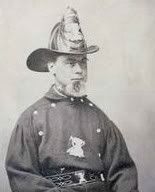Hold on this gets a bit sticky because of repeating first names.
William was the grandson of William Golcher (born 23 October 1795) of Darlaston, Staffordshire. William ( born 1795 ) had 13 children, many died in infancy. 2 of his children that lived were Joseph (who never left England) and James. Together they continued their father's lock making business. The Golcher's had started out as nail makers and became lock makers in the late 1700's. Their grand uncle had been a gunmaker for the American Revolution making barrels in Philadelphia.
In 1834 James had a son, William. In 1840, James immigrated and set up shop in Gettysburg, PA. In 1841, he sent for his wife and children. His son Thomas L Golcher was born in 1842. In 1843 or so, he moved his family and shop to Philadelphia were he reminded the rest of his life. William was foreman of his father's gun making business. In 1855, William moved to St Paul, MN. His brothers, Thomas and James moved to Joliet, IL, then to Chicago, IL. Eventually Thomas was to return to Philadelphia.
William became very involved in the life of St. Paul. He was a member of the first volunteer fire fighters. He was a member of the St Paul Shooting Club, devoted to live pigeon shoots. He was a commissioner that had several lakes stocked with trout in Minnesota ( he was a passionate fisherman ). He was on the St. Paul City Council. He retired and sold off his business in St. Paul, MN in 1873.

While in England he met J.P. Clabrough in 1877. Eventually, he purchased a controlling share in Clabrough's San Francisco business. William moved his family there. A Golcher ran the business until 1949.
Patent 88470 by William Golcher for breechloading shotgun. He also had patent 95998 for a breechloading rifle. In 88470 he states:
This invention is an improvement upon those guns in which, by moving a single lever, the breech of the barrel is thrown up, the gun cocked, and held in that position, and the old cartridge-shell retracted, while, by returning the lever to its original position, the barrel is brought down to its proper position for firing, and the gun is left cocked, and ready to be instantly discharged. The whole apparatus is exceedingly simple, cheap, and not liable to get out of order
Tunes, if that is your gun, please contact me at movie@damascus-barrels.com I have a request. That gun is only example I have seen of this patent. Many of William's early percussion guns are museum pieces today.
Pete